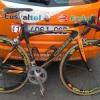| AhR and CYP enzymes |
| ↓AhR DNA binding; ↓expression and activity of CYP 1A1/1B1 | TCDD-treated MCF-10A cells [22] |
| ↓Expression and activity of CYP 1A1/1A2 | B[a]P-treated HepG2 cells and DMBA-treated MCF-7 cells [26] |
| ↓CYP 1A activity | Hepa1c1c7 cells [25] |
| ↓CYP 1A1 and CYP1B1 activity | In vitro study using human liver microsomes [29] |
| ↓Expression of CYP 1A1 | B[a]P-treated mouse lung tissue [27] |
| ↓CYP 19 (aromatase) activity | MCF-7 cells [30] |
| Direct interaction with CYP 19 | Molecular modeling and docking study [31] |
| |
| Phase II detoxification and antioxidant enzymes |
| ↑NQO-1 activity | Hepa1c1c7 murine hepatoma cells [25] |
| ↑Expression of protein and mRNA of NQO-1; ↑NQO-1 activity | Human K562 cells [36] |
| ↑Gastrointestinal GPx promoter activity | HepG2 cells [35] |
| ↑Expression of protein and mRNA and promoter activity of HO-1 | Human aortic smooth muscle cells [34] |
| ↑Expression of HO-1 protein and mRNA; ↑GCLC mRNA and GCLC promoter activity | PC12 cells [32] |
| ↑Expression of GCL | CSE-treated SAEC and A549 cells [37] |
| |
| Pro-inflammatory mediators |
| ↓Mammary tumorigenesis; ↓COX-2 | DMBA-induced rat mammary tumor and MCF-7 cells [152] |
| ↓Esophageal tumors; ↓COX-1 and COX-2; ↓PGE2 level | NMBA-treated F344 male rats [49] |
| ↓COX activity; ↓expression and activity of ODC | UVB-irradiated SKH hairless mouse skin [153] |
| ↓COX-2 mRNA and protein level; ↓PGE2 level; | Human mammary and oral epithelial cells [52] and [147] |
| ↓cox-2 promoter activity; ↓PKC activation; ↓AP-1 activity | |
↓Expression of iNOS and COX-2; ↓IκB degradation degradation | LPS- or IFN-γ-stimulated Raw 264.7 cells [47] |
↓Expression of COX-2, ↓IKK activity, ↓MAP kinase activation, ↓NF-κB and AP-1 DNA binding; ↓IκB phosphorylation and degradation, ↓p65 phosphorylation and nuclear translocation, ↓p65 and CBP interaction phosphorylation and degradation, ↓p65 phosphorylation and nuclear translocation, ↓p65 and CBP interaction | Female ICR mouse skin treated with TPA [48] and [154] |
| ↓NF-κB nuclear translocation; ↓NO production | Raw 264.7 and J774.2 cells treated with LPS [139] |
| ↓IL-8 production; ↓AP-1 activity | TPA-treated Myeloid (U937) cells [57] |
↓TNF- mRNA expression mRNA expression | LPS-treated J774.2 macrophages [54] |
| ↓Serum levels of IL-6 | Mice transplanted with L1210 cells [56] |
| |
| Components of cell cycle machinery |
| ↑p21 expression; G1 phase arrest | HepG2 cells [82] |
| ↑p21WAF1/CIP1 expression, ↓cyclin D1/D2-Cdk6 and ↓cyclin D1/D2-Cdk4 complex formation | A431 cells [63] |
| ↓Cyclin E-Cdk2 complex formation; ↓hyperphosphorylation of Rb; ↓free E2F | A431 cells [64] |
| ↓Expression of cyclin B1, D1, A1 and β-catenin | SW480 cells [69] |
| ↓Cyclin D1 and Cdk4 expression; ↑cyclin E and A expression; shifting of hyperphosphorylated Rb to hypophosphorylated form | Caco2 and HCT-116 cells [70] |
| ↓ERK phosphorylation, ↓ expression of cyclin D1/D2 | UVB-irradiated SKH-1 hairless mouse skin [65] |
| Causes G1 arrest, ↓cyclin A and D1, ↓Cdk-6, ↓ERK, ↓AP-1, ↑accumulation of hypophosphorylated Rb | A-431 cells [119] |
| Induces S phase arrest, ↑Cdc25c phosphorylation, | OVCAR-3 cells [71] |
| ↑Chk1/2 expression, ↑ATM kinase activity | |
| |
| Molecules of the apoptotic signaling pathway |
| ↑Expression of CD95L, ↑caspase-mediated PARP cleavage | HL-60 and T47D cells [75] |
| Redistribution of death receptors in membrane lipid rafts; ↑activation of caspases | SW480 cells [76] and [77] |
| ↓Akt phosphorylation, stimulation of death receptors, ↑caspase activation | PC-3 and DU-145 cells [79] |
| ↑Activation of ERK, p38 and JNK; ↑p53 phosphorylation | JB6 cells [86] and [87] |
| ↑Expression of p53 responsive genes: p53,p21, p300/CBPand Apaf-1 | LNCaP cells [85] |
| ↑MAP kinases; ↑ phosphorylation of p53; ↑p53 DNA binding | DU-145 cells [115] |
| ↓Bcl-2 expression; ↑Bax expression | Human esophageal cancer cells [155] |
| ↑Bax expression; ↑activation of caspase 3 and 9 | HCT-116 cells [84] |
| ↑Cytochrome c release; activation of caspase-3 | Human pancreatic cancer cells [156] |
| ↑Caspase 2, ↑mitochondrial translocation of Bid, ↑AIF, ↑caspase-3 and -9 | HCT-116 cells [88] |
| ↑Nuclear co-localization of COX-2, p53 and CBP, ↑phosphorylation of p53 | MCF-7 and MDA-MB-231 cells [91] |
Direct binding to integrin Vβ3, ↑p53-dependent apoptosis Vβ3, ↑p53-dependent apoptosis | MCF-7 cells [90] |
| ↑Mitochondrial ROS, ↑phosphorylation of ERK and p38 MAP kinases, ↑p53 phosphorylation, ↑p21, ↑pChk1, ↑ATM kinase, ↑senescence-like growth arrest | HCT-116 cells [81] |
| ↑Caspase-6-mediated cleavage of lamin A | HCT-116 (Bax+/−) cells [89] |
| ↑Cytochrome c release, ↑cleavage of caspase-9 and-3, and PARP, ↑expression of p53, ↑Bax expression, ↑APAF-1, ↓Bcl-2 | DMBA-TPA-induced mouse skin papillomas [74] |
| |
| Molecular switches of angiogenic and metastatic progression |
| ↓Secretion of VEGF | Human leukemia U937 cells [157] |
| ↓Phosphorylation of ERK, ↓Expression of MMP-9 | Heregulin-β1-treated MCF-7 cells [104] |
| ↓Expression of MMP-9 | DMBA-induced mouse mammary tumors [152] |
| ↓Expression and activity of MMP-2 and -9 | Multiple myeloma cells [103] |
↓HIF-1 protein expression, ↓VEGF expression protein expression, ↓VEGF expression | A2780/CP70 and OVCAR-3 cells [72] |
| ↓Extracellular levels of VEGF | MDA-MB-231 cells [12] |
↓Expression of protein and mRNA of HIF-1 and VEGF and VEGF | Human tongue squamous cell carcinomas and hepatoma cells [100] |
↓HIF-1 and VEGF expression and VEGF expression | LPA-treated ovarian cancer cells [101] |













































